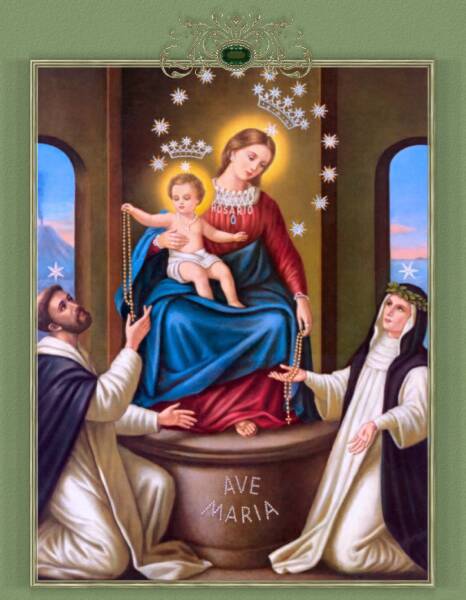
The term "rosary" comes from the Latin rosarium meaining "garden of roses". When we pray the Rosary we form a crown of roses to be offered to Our Blessed Mother.
The late centuries of the first millenium after the birth of our Savior gives evidence to the counting of prayers; specifically the Pater Noster (Our Father). Monastic orders prescribed the praying of the 150 psalms and to keep count, stones or other small bead-like objects would be used. These objects would be threaded onto a string or cord thus giving the form of a precursor to the Rosary.
To honor Our Lady then, the practice of reciting the Angelic Salutation was adopted in the form of the recitation of the 150 psalms. Much speculation surrounds the institution and evolution of the Rosary.
Tradition has it that in preaching against the Albigensian heresy near Toulouse St. Dominic, seeing the sinfulness and stubbornness of the people, left to the woods and inflicted upon himself severe penances and mortifications. So much so that he was rendered unconscious. Upon waking, he was met by the Blessed Virgin Mary who encouraged him and instructed him to pray her Angelic Salutation. It is said that this was in the form of 150 Angelic Salutations and 15 Our Fathers. Several popes attest to St. Dominic as the author of the Rosary in apostolic letters and encyclicals. Pope Benedict XIV (1740-1758) in response to being asked whether St. Dominic was the author of the Rosary cited the testimony of Leo X (1521), Pius V (1572), Gregory XIII (1585), Sixtus V (1590), Clement VIII (1605), Alexander VII (1667), Bl. Innocent XI (1689), Clement XI (1721), Innocent XIII (1724) firmly acknowledging St. Dominic as such.
What is known is that the Hail Mary did not start out in its current form. The Angelic Salutation "Hail full of grace, the Lord is with thee. Blessed art thou among women and blessed is the fruit of thy womb", taken from Scripture, is the precursor. The addition of the most holy name of JESUS after this first part of the prayer is attributed to St. Bernadine of Sienna (1380-1444).
The Our Father and the Glory Be were added some time later. The addition of the Glory Be is sometimes attributed to St. Louis de Montfort. The adoption of the original 15 mysteries is unclear. The 5 Luminous Mysteries of course were given to us by Pope John Paul II. The Fatima prayer was then added after the apparitions in 1917.